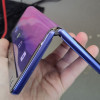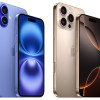Hands-On: Sony Ericsson Xperia X10
Nov 18, 2009, 4:46 PM by Eric M. Zeman
Today Phone Scoop got a sneak peak at Sony Ericsson's first Android phone, the Xperia X10. The hardware is mostly good and the 'Nexus' user interface offers a few elegant touches.
Sony Ericsson invited a few press types to a luncheon today in New York City to share some details about the upcoming Xperia X10 Android device.
First, a quick chat about the hardware. The X10 is a large, tablet-shaped device with a generous screen. It is made of plastics and feels OK. Sony Ericsson was sure to point out that both the hardware and software are not final builds.
The back surface of the X10 us curved, and feels good resting in your palm. The side surfaces are also curved — no sharp angles here. The weight is decent and it doesn't feel too heavy. It's a large phone, though, due to the screen size. Speaking of which, the screen is really nice. It has similar resolution to the Motorola Droid, and was sharp, bright, and colorful.
There are three buttons on the front, which open the menu, the home screen and take you back a screen. The buttons had acceptable travel and feedback, but they weren't great. There are no buttons on the left. The volume toggle and dedicated camera keys are on the right. Each is fairly easy to find and has good travel and feedback.
The microUSB port, 3.5mm headset jack and lock/power key are all on the top. I couldn't find a memory card slot, so it must have been under the batter cover.
Perhaps what's more interesting than the hardware of the X10 is that Sony Ericsson has taken a whole new direction with its user interface. It said that its new UX platform will be called Nexus, and it will spread beyond Android handset to those running other operating systems such as Windows Mobile, Symbian and possibly others. Sony Ericsson discounted the idea that Nexus would be applied to its Java devices.
Nexus centers around the idea of presenting users with the easiest ways possible to organize their data and to discover new data — be that friends, music, movies, restaurant ratings, whatever. The two cores behind this idea are Timescape and Mediascape.
Timescape encapsulates all of a users communications, be it IM, MMS, SMS, Twitter, Facebook, emails, calls or voicemails. They are presented in a graphical flow of information. The flows can be sorted, so a user can choose to look at just their email, or just their Facebook, or just their Twitter streams by pressing the appropriate software button on the screen. The idea reminds me of Motorola's MOTOBLUR, but this solution is a touch more refined and elegant.
If you want to drill down, pressing the "infinity" button on the screen will open all the messages sent by a single person, no matter what kind of message that is. So emails, calls, IM's Facebook status updates and so on all gets lumped together in one stream. It's cool, and you can flick through the stream to drill down further into specific messages.
Mediascape is essentially the same concept, but is applied to your music, videos and pictures. Not only does it allow users to access their own content, but to search for other content, as well. Nexus will analyze users' behavior and content and make recommendations on new content or applications that it thinks might match the users' interests.
It's neat stuff. Here's a video of it in action so you can get an idea of what I'm talking about:
Comments
T-mobile???
Anyone hear any solid info on if t-mobile will get this?
Eric...


















 TCL's New Foldable Concept Swings Both Ways
TCL's New Foldable Concept Swings Both Ways
 Hands On with the Motorola edge+ (2022)
Hands On with the Motorola edge+ (2022)
 iPhone 14 Plus Offers a Big Screen For Less
iPhone 14 Plus Offers a Big Screen For Less
 Samsung S24 Series Adds More AI, Updates the Hardware
Samsung S24 Series Adds More AI, Updates the Hardware
 iPhone 16 Brings More Features to All Price Points, Including New Camera Control
iPhone 16 Brings More Features to All Price Points, Including New Camera Control

